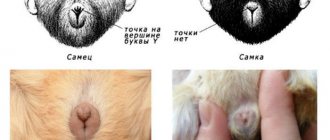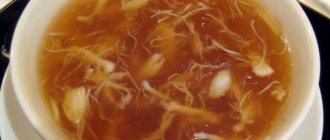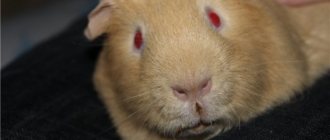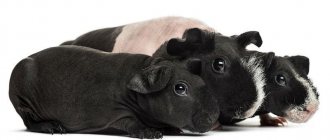- home
- Guinea pig
- Guinea pig health
02/07/2019 If a guinea pig has diarrhea, then help should be provided to the pet as soon as possible. The painful condition of an animal can be caused by various reasons. This article describes what to do with diarrhea, how dangerous it is and how to treat this disease.
Causes of diarrhea
Diarrhea in a guinea pig can be the result of an illness or a simple intestinal disorder. More specifically, these could be:
- Worm infestation;
- bacterial infections;
- fungi;
- stale water and food;
- cold;
- dental problems;
- nervous tension.
Regardless of the cause of diarrhea, your guinea pig must be taken to a veterinary clinic. Even intestinal upset due to inappropriate food can be fatal.
Prevention
The best treatment for diarrhea is proper and regular prevention. To minimize the chances of recurrence of the disease, follow some rules:
- Do not feed foods that have a laxative effect.
- When buying a pet, find out about its diet; an unexpected change can cause diarrhea.
- Before feeding the animal, check the food for quality.
- Clean and disinfect the cage and its contents regularly.
- Make sure that the greens are not rotten or wet.
- Food must be fresh, without signs of mold.
- Even if you walk your pet from time to time, movement helps improve immunity.
Follow these guidelines and your guinea pig will not have problems with diarrhea.
Symptoms
Diarrhea itself is a symptom of illness or digestive problems. In addition to diarrhea, your pet may experience accompanying symptoms:
- Rapid pulse;
- loss of appetite;
- loose stools;
- apathy;
- hard breath;
- painful sensations when palpating the abdominal area;
- temperature increase;
- rumbling in the stomach;
- blood in stool.
Even before severe diarrhea appears, foam appears in the pet’s excrement, the feces emit a strong unpleasant odor, the consistency of the excrement is softer than usual, and the excrement sticks to the animal’s butt and fur.
Signs of illness
Each affected rodent will exhibit its own symptoms depending on the cause of the disorder. But there are also general signs that indicate the animal’s poor health:
- apathy: the rodent reacts poorly to others, lies down more, tries to hide in a secluded corner, breathes heavily;
- lack of appetite;
- increased body temperature if there is an infectious onset of the disease;
- increased heart rate;
- chills;
- tousled fur;
- abdominal pain.
The following symptoms are observed with diarrhea:
- the anus area is contaminated with feces, the hair is stuck together, a characteristic fetid odor emanates from the animal;
- loose, frequent, foamy bowel movements,
- the stomach is swollen due to increased gas formation,
- By palpating the abdominal cavity, you can feel the movement of the intestines and even hear the characteristic rumbling and bubbling, indicating increased peristalsis of the digestive tube.
Constipation is characterized by:
- protrusion of the anus;
- absence of bowel movements for a long time;
- the presence of a hard cord in the intestine, which can be felt when palpating the abdomen;
- abdominal wall pain.
Kinds
The consistency of stool is an important factor in determining the cause of diarrhea. But only a veterinarian can determine the disease, having previously received test results.
Abnormal state of excrement:
- Liquid;
- watery;
- with blood;
- with foam.
If the feces are unformed, then your pet should be taken to the veterinarian. The presence of blood in the stool means there is internal bleeding. In this case, damage to internal organs or a tumor is suspected.
Diagnostic methods
When making a diagnosis, data from the anamnesis, clinical examination and research results are taken into account. The veterinarian takes into account the conditions in which the rodent is kept and its nutrition. The doctor should find out if the guinea pig has recently taken any medications.
Often, even when collecting an anamnesis and during an examination, it is possible to identify pathologies of cecotrophy and diseases that are usually accompanied by diarrhea. If necessary, additional studies will be carried out:
- clinical and biochemical blood test;
- X-ray of the abdominal organs;
- stool analysis and culture;
- Ultrasound of the gastrointestinal tract.
First aid
You should not self-medicate if your guinea pig has diarrhea. It is necessary to find out the cause in order to be sure that the correct treatment is prescribed and the disease is not dangerous to other animals and humans. But before your pet appears at the ratologist’s appointment, you can give your guinea pig for diarrhea:
- Smecta. A sixth of the sachet is dissolved in water and the pet is given water from a syringe without a needle.
- Activated carbon. The amount of the drug is calculated based on the weight of the animal; 1 gram of coal is taken per 1 kilogram of the pet’s weight. Then they are diluted in water and soldered to the pet.
Immediately after the first signs of diarrhea appear, it is necessary to change the water in the drinking bowl and add a few drops of potassium permanganate to it. This is necessary to disinfect the liquid.
Non-antibiotic-dependent dysbiosis
Enterotoxemia can be caused not only by taking antibiotics, but also by other reasons:
- stressful situation;
- abrupt transition to new food;
- changes in the composition of intestinal microflora.
In each of the listed cases, the appearance of diarrhea is an optional condition. Diarrhea may not occur with enterotoxemia. However, signs of deterioration in the guinea pig’s health are still present; the main thing is to detect them in time.
This:
- sudden weight loss;
- dehydration;
- depressive state.
Treatment
Diarrhea causes dehydration. To replenish the lack of moisture, the animal is given rice or oatmeal broth. In addition to replenishing fluid in the body, decoctions contribute to the formation of harder stool.
To clean the intestines, you need to give the rodent a solution of smecta, activated carbon or enterosgel.
The pet's cage is washed every time it gets dirty. Unpleasant odors aggravate the animal's unhealthy condition.
To cope with inflammation and consolidation of stool, the pet is given decoctions of chamomile and oak bark.
To treat diarrhea in a guinea pig, it is necessary to restore the intestinal microflora. The pig is given special probiotics for rodents. Probiotics for humans are strictly prohibited from being given to pigs due to the fact that they contain lactose. Animal products should not be given to these animals.
Symptoms of diarrhea in a guinea pig
Soft feces formed into small pellets are not diarrhea. However, many breeders perceive softened feces as a dangerous signal and begin to give their pigs medications, which leads to constipation. However, soft feces are just a consequence of the predominance of succulent food in the animal’s diet. For each animal, diarrhea occurs and proceeds differently.
The symptoms preceding diarrhea can be completely different and dissimilar, but there are a number of mandatory ones:
- Clumping of hair in the anal area,
- Small pieces of feces sticking to fur
- The smell of pigs becomes very pungent and unpleasant,
- The pig starts pooping often and a lot,
- Gas formation and bloating in the animal,
- When palpated, a rumbling in the tummy is clearly heard and a characteristic seething in the intestines is felt.
Diet for diarrhea
In case of diarrhea, juicy foods are removed from the usual diet. They are replaced with hay. The patient's menu includes solid vegetables, herbs, and grains. Be sure to ensure that the rodent drinks water.
After stool normalization, juicy fruits and vegetables are introduced little by little. If the situation repeats, then it is necessary to remove them from the diet and submit feces for analysis.
If food is refused, the pig is fed through a syringe. You should buy expensive, high-quality food and soak it.
Bacterial and viral infections
Diarrhea in a rodent can be caused by viruses or bacteria entering the body. So, in guinea pigs, diarrhea occurs due to the following diseases:
| Disease | Description and symptoms |
| Coronavirus | The disease affects young animals that have recently been weaned from their mother and is accompanied by diarrhea, weight loss and dehydration. Often pigs die suddenly. |
| Salmonellosis | The disease is rare in guinea pigs, but has a high mortality rate, killing every second animal. The infection is transmitted through contaminated food and drinking water. With salmonellosis, the feces become soft and acquire a yellow-green tint, the animal quickly loses weight, looks weakened, and the fur becomes ruffled. Some rodents develop conjunctivitis and females abort. |
| Colibacillosis | The causative agents are pathogenic strains of Escherichia coli. After infection, the pig becomes lethargic, refuses food, and profuse diarrhea with blood begins. The condition is rapidly deteriorating, rodents are dying from intoxication. |
| Tayser's disease | The causative agents are clostridia. Young animals, weakened and stressed animals are at risk. Clinical signs are apathy, unkempt fur, and watery diarrhea. |
| Pseudotuberculosis | This disease is in no way related to tuberculosis; it is caused by other bacteria. Among the symptoms, in addition to watery diarrhea with bloody inclusions, conjunctivitis, convulsions, and depression are observed. |
Of the parasitic diseases that cause diarrhea, the most common in guinea pigs are:
Parasitic:
- Cryptosporidiosis. Pathogens are simple microorganisms that affect the small and large intestines. Young guinea pigs and individuals with weakened immune systems are susceptible to the disease. In addition to diarrhea, rodents experience slower growth, emaciation, and their fur takes on a sloppy appearance.
- Coccidiosis. The causative agents are Eimeria. They parasitize the intestines. Coccidiosis mainly affects pigs weaned from their mother. Rodents develop colitis, which is accompanied by watery diarrhea.
Coccidiosis
Surgical pathologies
Inflammation of the appendix is difficult to diagnose in a baby in the first year of life, since the baby cannot show where it hurts. The disease is dangerous because it develops at a hurricane pace. And from the onset of the inflammatory process to the rupture of the organ, only a few hours can pass.
Symptoms of the pathological process:
- anxiety;
- weakness and apathy - the baby lies and does not want to play or move;
- forced pose - the toddler turns over on his right side and assumes a fetal position;
- fever, chills, fever;
- lack of appetite with increased thirst;
- vomit;
- diarrhea is profuse and repeated.
Such symptoms require immediate hospitalization of the child in the surgical department. If diagnosis is difficult, diagnostic laparoscopy is indicated.
FIGHTING SEA SICKNESS
Often, while on a trip, we experience symptoms of motion sickness: dizziness, nausea, headache, lack of appetite.
What is motion sickness and what is its cause? Motion sickness in transport
is the same as the so-called seasickness (in medical language - kinetosis, motion sickness).
Kinetosis was called “sea sickness” because people first encountered this phenomenon while traveling on water. Kinetosis occurs when we are exposed to monotonous vibrations - in a car, train, plane, boat, swing or merry-go-round. The cause of seasickness
is a malfunction of the vestibular apparatus, which is responsible for keeping us firmly on our feet.
It responds to changes in the position of the head and body in space, as well as to acceleration. When a person's body moves and sways in a car or on a ship, the brain receives conflicting information from different senses. Receptors in the vestibular system say that the body is motionless, but the eyes see that everything around is moving and swaying. This failure leads to dizziness and nausea. Most people have a vestibular system that is trained enough to easily tolerate these disruptions. People who get motion sickness in transport apparently have some genetic characteristics that cause the vestibular apparatus to fail to cope. Although there may also be provoking external factors: heat, stuffiness, the smell of tobacco, alcohol consumption, overwork, emotional stress, pregnancy. In children, the cause of kinetosis is often insufficient maturity of the hearing organ, where the vestibular apparatus is located, and the autonomic part of the nervous system. As you grow older, these phenomena disappear. To “trick” the bular apparatus, you can move your feet or shift from heel to toe. This will reduce the discrepancy between signals from different senses to the brain: the vestibular apparatus will think that you are walking on the ground. TRAINING THE VESTIBULAR APPARATUS: Stand next to a closet or at the back of a chair and make 1 turn clockwise. You can make one more turn to avoid falling. Turn around in the opposite direction counterclockwise 2 times. Do the exercise again, 2 turns in both directions. The next day, increase the number of turns by 1 in each direction, etc. “Planet Health”
talks with Doctor of Medical Sciences Irina Nikolaevna Kholodova, professor of the Department of Pediatrics with a course of outpatient pediatrics named after. G. N. Speransky RMANPO.
— Irina Nikolaevna, is motion sickness a disease?
- This is not a disease, but a symptom. But it may be a signal of some problems or diseases in the body that require mandatory clarification. This is often the result of inflammation of the ear, ailments of the autonomic nervous system, gastrointestinal tract, and tumors in the brain. If motion sickness is caused by a disease, it cannot be cured without treating the underlying disease. Nevertheless, motion sickness can be an individual physiological feature in completely healthy people. This greatly complicates a person’s daily life, since even an ordinary trip on public transport turns into a problem for him. And long trips become completely impossible. But motion sickness can be treated if you take this problem seriously and thoughtfully.
—Who usually gets seasick?
— The prevalence of motion sickness is extremely high. Studies have shown that motion sickness occurs in more than 60% of cases in children under 10 years of age. At the age of 10 to 20 years, motion sickness is noted by 45% of respondents. On average, 5–10% of people suffer from systematic motion sickness. Older people are much less likely to complain of motion sickness.
— How does motion sickness manifest itself in adults and children? Is there a difference in symptoms?
— Manifestations of kinetosis are the same in both children and adults: a feeling of nausea, vomiting, cold sweat, severe dizziness, a feeling of lack of air, panic. The only difference is in the causes of its occurrence - in children it is associated primarily with imperfections of the vestibular apparatus and nervous system. Childhood motion sickness most often goes away after adolescence. In adults, it is often not possible to find out the cause of kinetosis. It is believed that it may be caused by genetic characteristics, heredity, a sharp change in position in space, emotional stress, and impaired blood flow.
— What recommendations can you give before the trip?
— If possible, choose night trips. “Motion sickness” is due to the fact that visual signals and the sense of the body’s position in space do not coincide. A difficult journey can go better in the dark. You can try thick sleep glasses. In order to make your life easier, you need to follow simple recommendations. Firstly, two hours before travel it is better not to eat, drink alcohol or carbonated drinks. Secondly, on board the transport you need to be distracted and have fun, even if just to talk with a fellow traveler. In addition, you need to choose the right location. On a sea vessel these are cabins in the middle of the ship, closer to the waterline; on an airplane - seats close to the wings; in a car or bus - the front seats. In any transport, you should avoid seats located in the direction opposite to traffic. If we are talking about traveling on a ship, it is better to be at the stern and look not at the waves, but at the horizon line, which is motionless. In a car, it is optimal to sit in a seat next to the driver and keep an eye on the road. To avoid severe motion sickness, you should not read while in a moving vehicle.
— What to do if the disease takes you by surprise?
- If seasickness takes you by surprise, you need to let the patient swallow small pieces of ice and drink acidified water. Many people find that cold on the face, neck and a warm heating pad on their feet help. Another remedy is to establish deep rhythmic breathing (8-10 times per minute). A radical remedy for seasickness is to stop traffic and not use this type of transport in the future. Of course, if a person becomes ill in an elevator, there is no problem - climbing to the desired floor on your own is only good for your health.
- But what if you get motion sickness everywhere?
- In this case, training the vestibular apparatus will help. You can start riding on swings and rides. Balance exercises are very effective - for example, when you need to hold your body weight alternately on one leg and the other with your eyes closed, rotate your body and head in different planes, or exercise on a large gymnastic ball. Acrobatics, swimming, gymnastics, dancing, somersaults, trampolining, swimming, diving, skating and roller skating will also help strengthen the vestibular system. In the morning, you can do special gymnastics, with bending the torso and head, turns, somersaults, jumps, and various exercises on the horizontal bar. Start with a few repetitions, gradually increasing their number. Looking at the gadget, you can feel nauseous, even if you usually don’t get motion sickness in transport? — While in motion, for example, in a car, a person feels through the vestibular apparatus that he is moving with a certain acceleration and in a certain direction, but at the same time, the receptors of his muscles, bones and joints send information about his complete immobility. Such a contradiction between two streams of information irritates the centers that control balance and body position in space, which in turn causes dizziness, nausea and vomiting. And if at the same time a person is also looking at the gadget, his eye reacts to movements up, down, and to the side. As a result, random signals begin to enter the brain, which enhance kinetosis.
— What medications can be used to prevent and treat motion sickness?
— If the recommendations do not help, you can use drug therapy. The most promising is the use of natural preparations based on products of natural origin. They have proven effectiveness in practice, are safe, especially for children, and help get rid of the main symptoms of motion sickness without side effects or sedation. As a drug that satisfies all these requirements, the complex drug “Cocculin” can be recommended, which has been successfully used in France since 1969. It contains components that can eliminate all the symptoms of motion sickness described above. The peculiarity of “Cocculin” is that it can be prescribed to both adults and children, has an effect proven in clinical trials, and also has no side or toxic effects.
— What is the regimen for taking the drug “Cocculin”?
— The dosage regimen is simple: prevention — 2 tablets 3 times a day the day before and on the day of the trip; treatment - 2 tablets every hour until the condition improves.
The tablets should be slowly dissolved 20–30 minutes before meals or 1 hour after meals. The accumulated experience in the use of Cocculin allows us to recommend the drug for the treatment of children from 3 years of age and adults with symptoms of motion sickness in transport.
Preventive measures
The owner needs to pay attention to the prevention of diarrhea to reduce the risk of its occurrence. Bacterial and fungal infections are often the result of poor quality care
The cage should be washed regularly, and it and the animal’s equipment should be treated monthly with safe disinfectants. Guinea pigs are washed when they become dirty. Owners must take a responsible approach to choosing food for their pet. His diet should not include foods containing chemicals. Food and water must be fresh. At the first sign of spoilage or doubts about the quality, the food should be thrown away. This will help avoid intestinal disorders.
Probiotics intended for rodents should be given to the animal periodically. They will ensure the maintenance of healthy intestinal microflora
It is important to pay attention to strengthening the animal’s immunity. To do this, you should follow a diet that supplies all the necessary minerals and vitamins, and if they are deficient, give special complexes. The natural defense system is strengthened with regular physical activity.
To do this, the guinea pig needs to be given walks every day and let out of the cage. Active movements around the house will not only strengthen the immune system, they have a beneficial effect on intestinal motility
The natural defense system is strengthened with regular physical activity. To do this, the guinea pig needs to be given walks every day and let out of the cage. Active movements around the house will not only strengthen the immune system, they will have a beneficial effect on intestinal motility.
Diarrhea can also be a consequence of colds. Therefore, you need to install the cage in a place where there are no drafts. It should also be remembered that stress can cause diarrhea. This possibility must be excluded. The pet deserves careful, attentive treatment.
Authors of the articles: Belanta Clinic team











